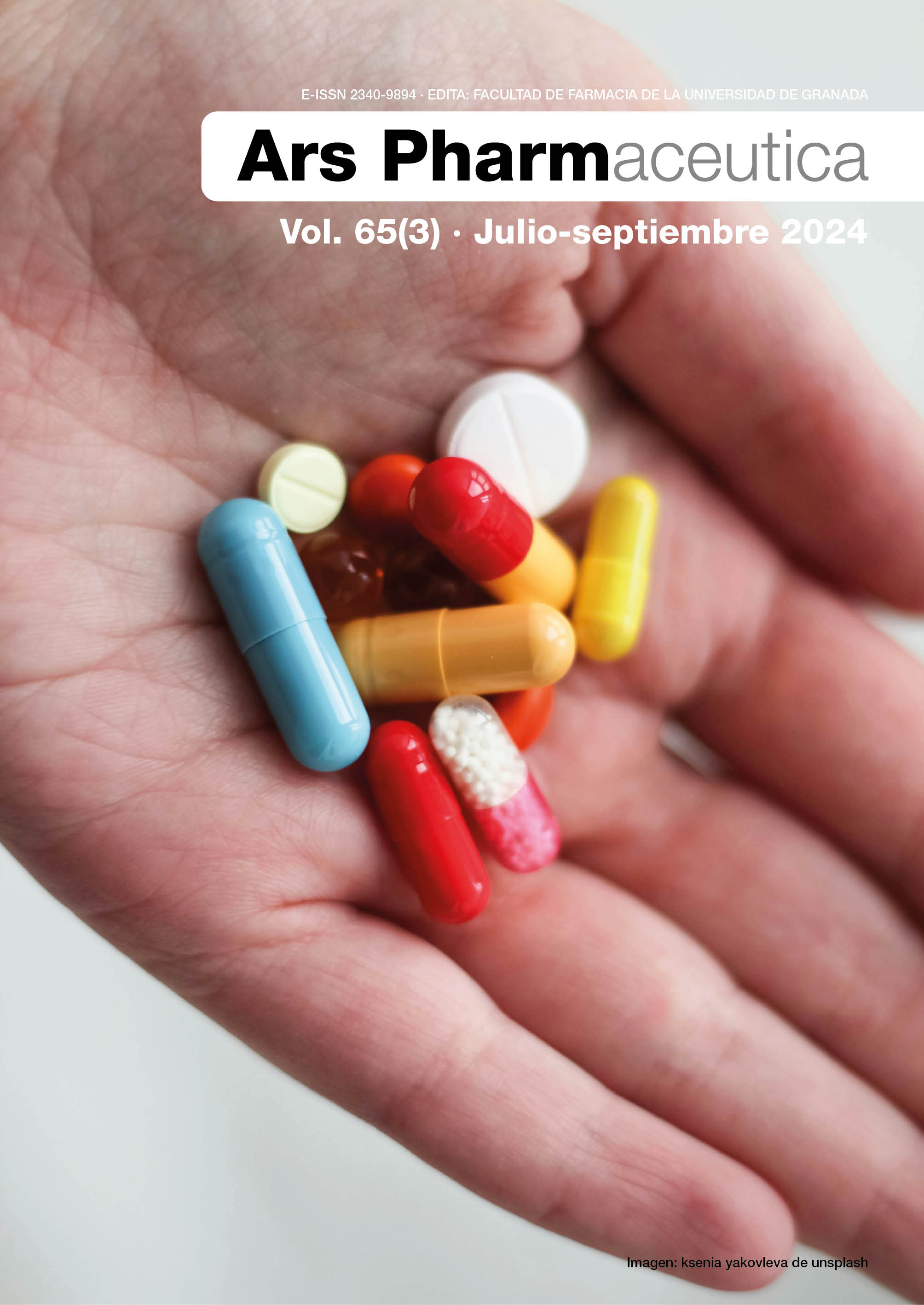Antibiofilm properties of garlic (Allium sativum) and its interaction with methicillin against methicillin-resistant Staphylococcus aureus
DOI:
https://doi.org/10.30827/ars.v65i3.30383Keywords:
Garlic, antibiofilm, diallyl sulphide, methicillin-resistant Staphylococcus aureus (MRSA)Abstract
Introduction: Garlic (Allium sativum) is a popular food spice worldwide with many health benefits. Garlic and its products have been used to treat various infections in traditional medicine in India, the Middle East, and Southeast Asia. Garlic and its organosulphur compounds have antibacterial properties against methicillin-resistant Staphylococcus aureus (MRSA), but the antibiofilm property and interaction with methicillin have been relatively unexplored. Biofilm formation is crucial in MRSA infections, one of the most common nosocomial infections.
Method: The antibacterial activity fresh garlic extract (FGE) against MRSA was evaluated by determining the minimum inhibitory concentration (MIC) and zone of inhibition using microdilution and well diffusion assays respectively. Microtiter plate crystal violet assay and scanning electron microscopy was use to evaluate the antibiofilm activity of FGE against MRSA.
Results: Sub-MIC concentrations of FGE significantly reduce methicillin-susceptible S. aureus (MSSA) and MRSA biofilm formation. Scanning electron microscopy analysis suggests that FGE reduces the attachment of MSSA and MRSA. Diallyl sulphide, one of the organosulphur compounds of garlic, inhibited the biofilm formation of MSSA and MRSA. Sub-MIC concentration of FGE also sensitized MRSA to methicillin, completely inhibiting MRSA growth when used in combination. Similar effects were noticed when FGE was combined with other β-lactam antibiotics to which MRSA was resistant.
Conclusions: The study validates garlic as an antibacterial agent in ethnomedicine through scientific evidence. Garlic and its organosulphur compounds are potential antibiofilm agents against MRSA. Moreover, garlic could be potentially used as a complementary or alternative medicine to treat infections caused by drug-resistant bacteria such as MRSA.
Downloads
References
Turner NA, Sharma-Kuinkel BK, Maskarinec SA, Eichenberger EM, Shah PP, Carugati M, et al. Methicillin-resistant Staphylococcus aureus: an overview of basic and clinical research. Nat Rev Microbiol. 2019;17(4):203-18.doi: 10.1038/s41579-018-0147-4 DOI: https://doi.org/10.1038/s41579-018-0147-4
Stewart S, Robertson C, Pan J, Kennedy S, Haahr L, Manoukian S, et al. Impact of healthcare-associated infection on length of stay. J Hosp Infect. 2021;114:23-31.doi: 10.1016/j.jhin.2021.02.026 DOI: https://doi.org/10.1016/j.jhin.2021.02.026
Centers for Disease C, Prevention. Antibiotic resistance threats in the United States, 2019. In: Centers for Disease C, Prevention, National Center for Emerging Z, Infectious Diseases . Division of Healthcare Quality Promotion. Antibiotic Resistance C, Strategy U, eds. Atlanta, GA: doi: 10.15620/cdc:82532; 2019.
Otter JA, Yezli S, French GL. The role played by contaminated surfaces in the transmission of nosocomial pathogens. Infect Control Hosp Epidemiol. 2011;32(7):687-99.doi: 10.1086/660363 DOI: https://doi.org/10.1086/660363
Coughenour C, Stevens V, Stetzenbach LD. An evaluation of methicillin-resistant Staphylococcus aureus survival on five environmental surfaces. Microb Drug Resist. 2011;17(3):457-61. doi: 10.1089/mdr.2011.0007 DOI: https://doi.org/10.1089/mdr.2011.0007
Piechota M, Kot B, Frankowska-Maciejewska A, Grużewska A, Woźniak-Kosek A. Biofilm Formation by Methicillin-Resistant and Methicillin-Sensitive Staphylococcus aureus Strains from Hospitalized Patients in Poland. BioMed Res Int. 2018;2018:4657396. doi: 10.1155/2018/4657396 DOI: https://doi.org/10.1155/2018/4657396
Bhatwalkar SB, Mondal R, Krishna SBN, Adam JK, Govender P, Anupam R. Antibacterial Properties of Organosulfur Compounds of Garlic (Allium sativum). Front Microbiol. 2021;12:613077. doi: 10.3389/fmicb.2021.613077 DOI: https://doi.org/10.3389/fmicb.2021.613077
Tsao SM, Hsu CC, Yin MC. Garlic extract and two diallyl sulphides inhibit methicillin-resistant Staphylococcus aureus infection in BALB/cA mice. J Antimicrob Chemother. 2003;52(6):974-80. doi: 10.1093/jac/dkg476 DOI: https://doi.org/10.1093/jac/dkg476
Farrag HA, Hosny A, Hawas AM, Hagras SAA, Helmy OM. Potential efficacy of garlic lock therapy in combating biofilm and catheter-associated infections; experimental studies on an animal model with focus on toxicological aspects. Saudi Pharm J. 2019;27(6):830-40. doi: 10.1016/j.jsps.2019.05.004 DOI: https://doi.org/10.1016/j.jsps.2019.05.004
Bhatwalkar SB, Gound SS, Mondal R, Srivastava RK, Anupam R. Anti-biofilm and Antibacterial Activity of Allium sativum Against Drug Resistant Shiga-Toxin Producing Escherichia coli (STEC) Isolates from Patient Samples and Food Sources. Indian J Microbiol. 2019;59(2):171-9. doi: 10.1007/s12088-019-00784-3. DOI: https://doi.org/10.1007/s12088-019-00784-3
Published
How to Cite
Issue
Section
License
Copyright (c) 2024 Sushma Bagde Bhatwalkar, Rajesh Mondal, Rajaneesh Anupam

This work is licensed under a Creative Commons Attribution-NonCommercial-ShareAlike 4.0 International License.
The articles, which are published in this journal, are subject to the following terms in relation to the rights of patrimonial or exploitation:
- The authors will keep their copyright and guarantee to the journal the right of first publication of their work, which will be distributed with a Creative Commons BY-NC-SA 4.0 license that allows third parties to reuse the work whenever its author, quote the original source and do not make commercial use of it.
b. The authors may adopt other non-exclusive licensing agreements for the distribution of the published version of the work (e.g., deposit it in an institutional telematic file or publish it in a monographic volume) provided that the original source of its publication is indicated.
c. Authors are allowed and advised to disseminate their work through the Internet (e.g. in institutional repositories or on their website) before and during the submission process, which can produce interesting exchanges and increase citations of the published work. (See The effect of open access).























